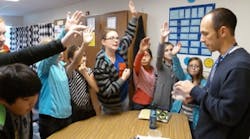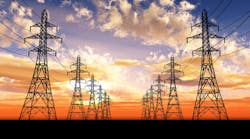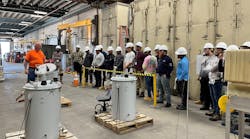Several educational programs got a recent boost when the Bonneville Power Administration made grants totaling $20,000 to further science and technology education in the Northwest.
From construction of hydroelectric, wind turbine and solar fuel-cell models to empowering students to develop sustainability plans for their schools, BPA is partnering for the third year with educators in its service territory through its Science and Energy Education Grants Program.
Six finalists received grants ranging from $2,000 to $5,000. In all, 38 proposals from the region were received.
“What impressed me the most about these grants is that the teachers are transforming their lessons into real-world actions,” said BPA Deputy Administrator Greg Delwiche. “The students will act as ambassadors in clean energy in their school districts or design sustainability plans for their school. So our investment has an immediate and exponential pass-through effect.”
The Science and Energy Education Grants Program advances student awareness, understanding and interest in the issues and science involved in energy generation and transmission in the Pacific Northwest. The grants support science, technology, engineering and math education with specific emphasis on electric utility issues.
“As stewards of the federal power generation and transmission system on the Columbia River, we are constantly looking for ways to help ensure future energy users have a rich understanding and appreciation for the incredible energy resources of the Pacific Northwest, beginning and founded upon our federal hydro system,” Delwiche said. “It’s also critical that we ensure that we have a future workforce with the skills needed to solve our energy problems of the future. Partnering with local educators is a great way to do this.”
A common theme in this year’s successful applications is the creation of a program that will provide lasting impact, beyond the initial participating students.
Recipients of the 2014-2015 BPA Science and Energy Education Grants are:
Dufur School, Dufur, Ore. -- $2,000 to fund the “Dufur Ranger Energy Generation Challenge.” Funds will be used to enable students at this small rural school to conduct a four-month study of different sources of renewable energy. Students will construct, test and modify models of hydroelectric, wind turbine and solar fuel cells. They will analyze the data from each and conduct comparisons. Then they will share the results of their studies with the community at a “Family Night at the Lab” event.
Ukiah School District, Ukiah, Ore. -- $1,891 for “Energy and Engineering STEM Program.” Funds will be used to purchase equipment and supplies for use in a new Energy and Engineering STEM class at this K-12 school of 50 students. The class will be offered in the fall for older students, and the materials will also be used by general science classes for younger students and local 4-H science clubs for summer programs. Science teachers will use blogs to share information on the development of the course with other teachers in the area. The materials will be used each year, providing a long-lasting impact to this school.
Montana Outdoor Science School, Bozeman, Mont. -- $5,000 to fund “Sustainable Energy.” Funds will be used for a six-week unit for middle school students in western Montana. Kids will develop their research and science skills as they test and optimize solar cells, design and test hydroelectric turbines and generators, and compare and contrast our current energy sources and usage. The final product for the unit will be a sustainability plan for their school, home or classroom to lower energy use.
Olympia School District, Olympia, Wash. -- $3,500 to support “Pathways to a Clean Energy Future through Science, Technology, Engineering and Math.” Funds will be used with this program that targets sixth graders in the accelerated math and science program, teaching them about the technological, social and environmental realities of energy demand and generation in the Pacific Northwest. It will also explore the benefits and challenges of energy conservation and efficiency at school and at home. The program funds students in six middle schools to participate in the EPA’s Battle of the Buildings competition, reaching more than 1,800 elementary, middle and high school students in seven schools throughout the district.
Sustainable Living Center, Walla Walla, Wash. -- $4,362 to fund “Energy Explorers Make a Splash!” The funds will be used on a project that will turn fifth graders in the Walla Walla Public Schools Highly Capable Learners program into energy instructors. They will get a series of eight weekly lessons outside of their regular classroom time on hydroelectricity, wind, solar, gas and nuclear energy, the future of energy generation, and challenges with energy production in our region. Next, they will share their knowledge by leading small group learning sessions for the rest of the district’s fifth-grade students at an annual two-day educational event called “Make a Splash,” at Walla Walla Community College in the spring.
White Salmon Valley (Wash.) Education Foundation -- $3,300 to fund “Climate Change and Hydropower in the Pacific Northwest.” The funds will be leveraged with this program to help students master science education standards by exploring the relationship between climate change and hydropower in the Northwest. The curriculum, designed for high school students, will include 10 in-class lessons, three field trips and training for the high school students to teach core concepts of the curriculum to students in fourth and seventh grade. The curriculum, which will also include elements for second-language learners and those with special-education needs, is expected to be in place for at least four academic years for students in Skamania and Klickitat counties, Wash.
The Science and Energy Education grant program is open to nonprofit 501(c)(3) tax-exempt organizations, government agencies and school districts. Applications are due in May, and funding is granted in early summer for the upcoming school year. Recipients are required to be from, and use provided funding in BPA service territory in Washington, Idaho, Oregon and parts of Montana, Nevada and Wyoming. Complete details are posted on the BPA education website.
BPA’s education program provides free presentations and information to K-12 schools in our region to help students achieve energy literacy, and to support science, technology, engineering and math education.


